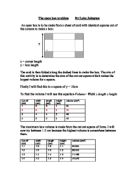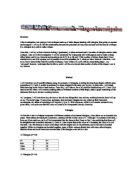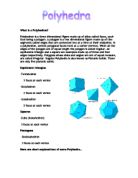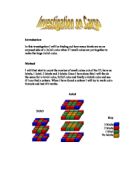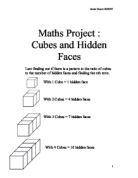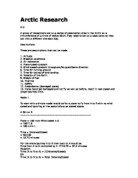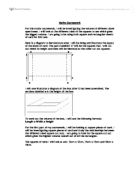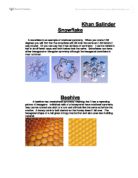Tbe Open Box Problem
The open box problem By Luke Johnston An open box is to be made from a sheet of card with identical squares cut of the corners to make a box: y x = corner length y = box length The card is then folded along the dashed lines to make the box. The aim of this activity is to determine the size of the cut out square which makes the largest volume for a square. Firstly I will find this in a square of y = 10cm To find the volume I will use this equation-Volume= Width x length x height Cut off (cm) width (cm) length (cm) height (cm) volume (cm²) 8 8 64 2 6 6 2 72 3 4 4 3 48 4 2 2 4 6 The maximum box volume is made from the cut out square of 2cms. I will now try between 1-2 cm because the highest volume is somewhere between them. Cut off (cm) width (cm) length (cm) height (cm) volume (cm²) .1 7.8 7.8 .1 66.924 .2 7.6 7.6 .2 69.312 .3 7.4 7.4 .3 71.188 .4 7.2 7.2 .4 72.576 .5 7 7 .5 73.5 .6 6.8 6.8 .6 73.984 .7 6.6 6.6 .7 74.052 .8 6.4 6.4 .8 73.728 .9 6.2 6.2 .9 73.036 2 6 6 2 72 The highest value of x is 1.7, but once again I will find a volume even higher in the 10 by 10 box by going into two decimal places. Cut off (cm) width (cm) length (cm) height (cm) volume (cm²) .61 6.78 6.78 .61 74.0091 .62 6.76 6.76 .62 74.0301 .63 6.74 6.74 .63 74.047 .64 6.72 6.72 .64
GCSE Math Coursework - Shapes Investigation
Summary I this investigation I am going to look at shapes made up of other shapes (starting with triangles, then going on squares and hexagons. I will try to find the relationship between the perimeter (in cm), dots enclosed and the amount of shapes (i.e. triangles etc.) used to make a shape. From this, I will try to find a formula linking P (perimeter), D (dots enclosed) and T (number of triangles used to make a shape). Later on in this investigation T will be substituted for Q (squares) and H (hexagons) used to make a shape. Other letters used in my formulas and equations are X (T, Q or H), and Y (the number of sides a shape has). I have decided not to use S for squares, as it is possible it could be mistaken for 5, when put into a formula. After this, I will try to find a formula that links the number of shapes, P and D that will work with any tessellating shape - my 'universal' formula. I anticipate that for this to work I will have to include that number of sides of the shapes I use in my formula. Method I will first draw out all possible shapes using, for example, 16 triangles, avoiding drawing those shapes with the same properties of T, P and D, as this is pointless (i.e. those arranged in the same way but say, on their side. I will attach these drawings to the front of each section. From this, I will make a list of all possible combinations of P, D and T (or later
Regular Polyhedra
What is a Polyhedron? Polyhedron is a three dimensional figure made up of sides called faces, each face being a polygon. A polygon is a two dimensional figure made up of line segments called edges that are connected two at a time at their endpoints. In a polyhedron, several polygonal faces meet at a corner (vertex). When all the edges of the polygon are of equal length the polygon is called regular. An equilateral triangle and a square are examples made up of three and four edges respectively. Polygons whose sides and angles are not of equal measure, are called irregular. Regular Polyhedra is also known as Platonic Solids. There are only five platonic solids. Equilateral triangles -Tetrahedron 3 faces at each vertex -Octahedron 4 faces at each vertex -Icosahedron 5 faces at each vertex Squares -Cube (hexahedron) 3 faces at each vertex Pentagons - Dodecahedron 3 faces at each vertex Here are short explanations of some Polyhedra... Tetrahedron This is the simplest of all the polyhedra. It uses the least number of faces to enclose any three-dimensional space. The polygon that makes up these faces is also the simplest polygon. Tetrahedron has 4 vertices, 6 edges and 4 faces. Hexahedron Hexahedron is the most common polyhedron. A hexahedron is a polyhedron with six faces. It is often called cube. The thing about the cube (hexahedron) is that all the other
Exposed cube sides
Introduction In this investigation I will be finding out how many labels are on an exposed side of a 3x3x3 cube when 27 small cubes are put together to make the large 3x3x3 cube. Method I will first start to count the number of small cubes out of the 27; have no labels, 1 label, 2 labels and 3 labels. Once I have done this I will the do the same for a 4x4x4 cube, 5x5x5 cube and finally a 6x6x6 cube and see if I can find a pattern. When I have found a pattern I will try to work out a formula and test if it works. 4x4x4 3x3x3 Key 3 labels 2 labels 1 label No labels 6x6x6 5x5x5 Results 3x3x3 4x4x4 5x5x5 6x6x6 3 labels 8 8 8 8 2 labels 2 24 36 48 labels 6 24 54 96 No labels 8 27 64 Formula The pattern for 3 labels is 8, 8, 8... U3 = 8 = 0x3+8 U4 = 8 = 0x4+8 U5 = 8 = 0x5+8 Un = 0n+8 The pattern for 2 labels is 12, 24, 36, 48... U3 = 12 = 12x3-24 U4 = 24 = 12x4-24 U5 = 36 = 12x5-24 Un = 12(n-2) The pattern for 1 label is 6, 24, 54, 96... U3 = 6 = 6x1 = 6x1² = 6(3-2) ² U4 = 24 = 6x4 = 6x2² = 6(4-2) ² U5 = 54 = 6x9 = 6x3² = 6(5-2) ² Un = 6(n-2)² The pattern for no labels is 1, 8, 27, 64... U3 = 1 = 1³ = (3-2) ³
Maths Project : Cubes and Hidden Faces
Maths Project : Cubes and Hidden Faces I am finding out if there is a pattern to the ratio of cubes to the number of hidden faces and finding the nth term. With 1 Cube = 1 hidden face With 2 Cubes = 4 hidden faces With 3 Cubes = 7 hidden faces With 4 Cubes = 10 hidden faces With 5 Cubes = 13 hidden faces With 6 Cubes = 16 hidden faces Already I can see a pattern, which is that with each cube, added there are 3 more hidden faces. Now I will try to find the nth term. 1st 2nd 3rd 4th 5th 6th 1 4 7 10 13 16 3 3 3 3 3 3X1=3 and I need 1 3X2=6 and I need 4 3X3=9 and I need 7 3X4=12 and I need 10 It looks like that I have to-2 to get the numbers I want so the nth term is 3n-2. To find the 100 you time 3 by 100 and-4 which = 296 Using this nth term I have made a table with out having to draw all of the pictures. Number of cubes Number of hidden faces 2 4 3 7 4 0 5 3 6 6 7 9 8 22 9 25 0 28 1 31 2 34 3 37 4 40 5 43 6 46 7 49 8 52 9 55 20 58 Hidden Faces Part 2 I am still looking for the pattern but this time using different shapes. 2 cubes = 4 hidden faces. 4 cubes = 12 hidden faces 6 cubes = 20 hidden Faces 8 cubes = 28 hidden faces This time the pattern goes up in 8 and I will now find the nth term. st 2nd 3rd 4th 4 12 20 28 8 8 8 8X1= 8 and I need 4 8X2= 16
A group of researchers set up a series of observation sites in the Arctic on a circumference of a circle of radius 50km.They need to set up a base camp so they can visit a different site each day.
Arctic Research Aim A group of researchers set up a series of observation sites in the Arctic on a circumference of a circle of radius 50km.They need to set up a base camp so they can visit a different site each day. Assumptions These are assumptions that can be made. . Altitude 2. Weather conditions 3. Air resistance 4. Plane speed constant 5. Wind speed constant throughout/No gust/Same direction 6. Time for turning around 7. Time for taking off and landing 8. Rotation of the Earth 9. Weight of fuel 0. Thermal 1. Safety 2. Breakdowns (damaged plane) 3. Plane could get damaged and not fly as well as before, result in less speed and longer journey time. Model 1 To start with a simple model would be for a plane to fly from A to B with no wind speed and ignoring all the assumptions as stated above. A 50 km B --------------------------------------------------------------------- Plane = 100 mph Wind speed = 0 = 100*1.6 = 160 kmh-1 Time = Distance/Speed = 50/160 = 18.75 minutes For the whole journey A to B then back to A would be: Time from A to B multiplied by 2. 2*18.75 = 37.5 minutes Equation Time (A to B to A) = 2(Distance/Speed) OR Time (A to B to A) = Total Distance/Speed Model 2 . Base at centre of the 360 degree circle 2. Wind speed 25kmh from the west 3. Plane travelling at a different speeds but with the same resultant (100kmh) 4. Same
GCSE Maths Coursework - Shapes Investigation
GCSE Maths Coursework - Shapes Investigation Summary I am doing an investigation to look at shapes made up of other shapes (starting with triangles, then going on squares and hexagons. I will try to find the relationship between the perimeter (in cm), dots enclosed and the amount of shapes (i.e. triangles etc.) used to make a shape. From this, I will try to find a formula linking P (perimeter), D (dots enclosed) and T (number of triangles used to make a shape). Later on in this investigation T will be substituted for Q (squares) and H (hexagons) used to make a shape. Other letters used in my formulas and equations are X (T, Q or H), and Y (the number of sides a shape has). I have decided not to use S for squares, as it is possible it could be mistaken for 5, when put into a formula. After this, I will try to find a formula that links the number of shapes, P and D that will work with any tessellating shape - my 'universal' formula. I anticipate that for this to work I will have to include that number of sides of the shapes I use in my formula. Method I will first draw out all possible shapes using, for example, 16 triangles, avoiding drawing those shapes with the same properties of T, P and D, as this is pointless (i.e. those arranged in the same way but say, on their side. I will attach these drawings to the front of each section. From this, I will make a list of all
Investigate different shapes of guttering for newly built houses.
Introduction For my maths coursework I was required to investigate different shapes of guttering for newly built houses. The purpose of guttering is to catch as much water running of the roof as possible. The guttering for newly built houses needs to have as large an area as possible so it can hold as much rainwater as possible. For the purpose of this investigation the material used for the production of the guttering will have a fixed width of 30cm. I will be investigating 6 different shapes: * Triangle * Rectangle * Square * Semi-circle * Half-octagon * Trapezium Task Guttering A firm has been asked to make guttering for newly built houses. Investigate Plan To investigate which type of shape will hold the maximum amount of water, I will be calculating the area of the cross-section of each different type of guttering. If possible, I will be changing the variables until I find the maximum area for each shape, the variables being length of sides and size of angles. I will then compare the highest values of each shape and pick the one with the maximum area. Formulas Triangle Area = 1/2 a?b?sin c Rectangle Area = a?b Square Area = l?h Semi-circle Area = 1/2?? ?r² Half-octagon Area = divide the shape into triangles, work out the area of each triangle and then add them together Trapezium Area = 1/2 (a+b)?h Triangle In the case of the
This report is about working out the formula to a hidden faces equation, I will find the nth term, put my results into a table and, figure out if the formula works.
Introduction This report is about working out the formula to a hidden faces equation, I will find the nth term, put my results into a table and, figure out if the formula works. Method I am going to find out how many hidden faces (the faces that aren't visible from any angle) there on cube 2 cubes 3 cubes 4 cubes 5 cubes 6 cubes 7 cubes 8 cubes 9 cubes I am doing this to try and find an easier way to find out how many hidden faces there are in.... say 100 cubes rather than do trial and error, or put cubes together and work it out. I will record my results in a table that has 3 columns, , number of cubes 2, number of hidden faces 3, the formula I will prove this by picking a low number like..1, and a really high one like 100 and test my formula on it. Hypothesis I predict that the formula is 3n-2. Number of cubes Number of hidden faces Formula 3n-2 2 4 3N-2 3 7 3N-2 4 0 3N-2 5 3 3N-2 6 6 3N-2 7 9 3N-2 8 21 3N-2 9 24 3N-2 My formula works because 3n-2 = 3X1-2 31=3 3-2=1 it works with all numbers 3n-2 = 3X6-2 3X6=18
Graphs of Sin x, Cos x; and Tan x
Graphs of sinx°, cosx° and tanx° Here are the sketch graphs of the trigonometric functions f(x) = sinx°, f(x) = cosx° and f(x) = tanx°. You may be asked to draw or sketch these graphs in your exam. Try to remember what they look like, and follow these tips: If you are asked to draw or plot the graph, you will need to use your calculator to generate the y-values. For example, if you were asked to plot the graph of f(x) = sinx° for 0° x 360° , you would use you calculator to find sin0°, sin10°, sin 20°, ...., sin 360° and then plot these values on the graph paper. Plotting a trigonometric graph is time-consuming and it is therefore more likely that you will be asked to sketch the graph. However, even if you think that you remember what the graph looks like, your calculator can be used to check. For example, sin0° = 0 and cos0° = 1, so you have the starting points of the graphs. Tan90° has no value (your calculator will display an error message), so you know that the graph cannot cross the line x = 90°. Transformations of graphs; y = asinbx° and y = acosbx° Remember Given a graph, f(x): * The transformation af(x) causes a stretch, parallel to the y-axis with a scale factor of a. * The transformation f(bx) causes a stretch, parallel to the x-axis with a scale factor of . These rules also apply to trigonometric graphs Question 1 See whether you can


